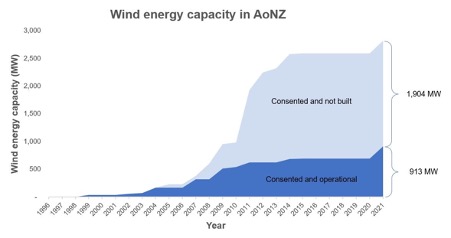One of the issues facing our energy system is that it was re-structured by Max Bradford in the 1990’s with the misguided idea that competition would lead to “efficiencies”.
The trouble is a consent is not worth much unless a board of directors and shareholders agree to invest privately-managed capital in actually building that power generation. Their track record is not good from an electricity production and power price point of view. There are currently 1,904 MW worth of wind farms that have been consented for an average of 13 years and have not been built because the big four privately-run (but mostly state-controlled) gentailers fear all the extra supply would drive down prices, profits, and dividends.
You can’t generate power from a consent

Energy and Environment Ministers Megan Woods and David Parker yesterday announced fast-tracking for a combined 1,579 MW of solar and wind farms, including the following:
- Contact Energy’s proposal is to operate 55 wind turbines, generating 300 MW at peak output, on a site east of Wyndham in Southland;
- An 18-turbine wind farm at Waiuku near Auckland to produce 80 MW at peak output;
- NZ Windfarms’ proposal to operate nine turbines at the Te Rere Hau Wind Farm near Woodville to generate to 39 MW at peak output;
- Fast-tracked consenting for 1.9 million solar panels over nine solar farms with a total peak capacity of 1,147 MW, including Harmony Energy Solar Ltd’s projects near Marton, Opunake and Carterton, and Energy Farms Ltd’s projects near Rangitikei and Taranaki; and,
- the Rangiriri Solar Farm and Waerenga Solar Farm projects able to displace 220m kgs of carbon emissions
Woods certainly painted the news as a good thing:
“Solar energy helps keep household power bills lower and, like all renewable electricity development, builds resilience into our energy network.
“The Government’s goals are for half of New Zealand’s total energy needs to be met by renewable energy by 2035, and for 100 per cent of energy generation to be renewable by 2050.”
The problem is solar is unloved by the established network providers and distributors, who have to invest in new lines to these farms and then deal with the intermittent nature of solar and wind power. They are also incentivised to starve the market of new investment to keep pushing up prices.
Wind production has stablised at around 640 MW per quarter for the last eight years, and solar has risen from around 15 MW to barely 100 MW per quarter over that period. In other countries, solar and wind have risen much faster.
I can only ask why on earth would anyone want to invest in expensive, and not particularly environmentally sound, technology that has to rely on increasingly fickle weather conditions in order to generate electricity? Warren Buffet apparently has said the only reason to invest in wind technology is to collect the huge subsidies available. And I won’t get on to offshore wind, for which the prospect in NZ anytime soon I think is delusional.
HI Gary,
Can’t understand the mania for solar farms when local generation from people’s houses and commercial buildings that is shared locally is so much better. No extra land taken up and neglibile transmission losses if the electricity is used locally.